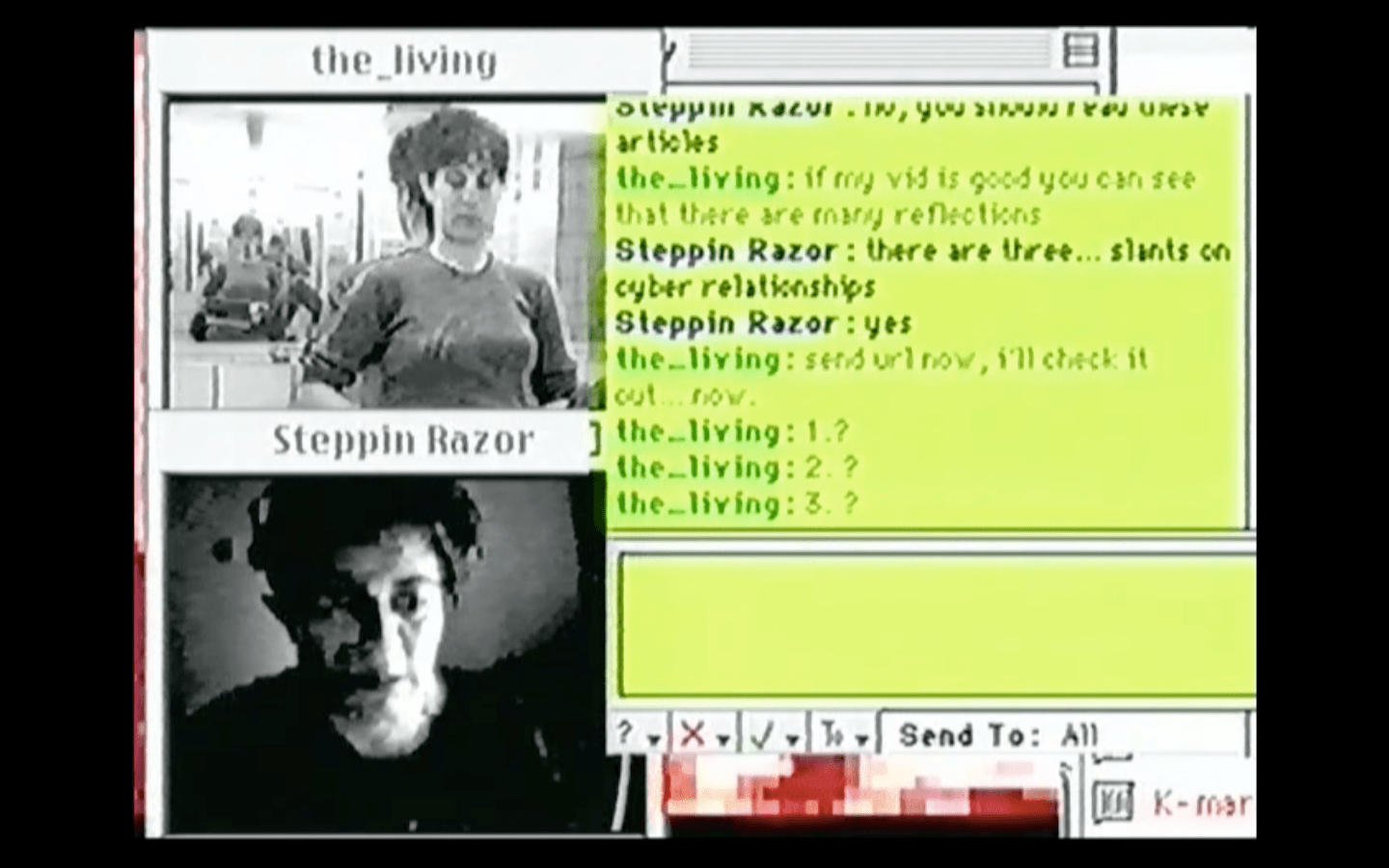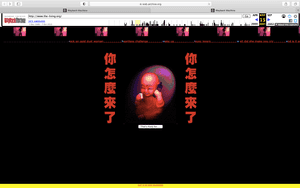
the_living (1997-1998) - Debra Solomon
In collection of LI-MA
Brief Description of the Work
In 1997, Debra Solomon created the_living on CU-SeeMe: software that allows for point-to-point video calls and online chat boxes. the_living was considered Solomon’s online digital persona. She would appear in unusual places such as in swimming pools, interacting with her audience through a virtual video conference environment. In the meantime, the_living would send her users 'Tamagotchi gifts' in the form of animation and midi files displayed on the website www.the-living.org. Solomon broadcasted the life of the_living through a series of pre-recorded videos titled 'Wardrobe of live moments' by hosting and joining different CU-SeeMe reflectors in a 'situationist' manner (see below). In the year-long online performance, the artist imagined the future of being online 24 hours a day, and explored the increasing blurry boundaries between the physical and the virtual worlds.
Virtual Persona in Early Internet Culture
Driven by the fascination with the Internet as a communication network, the popularization of cyberpunk as a genre, and renewed demands from the Third-wave feminist movements, the late 1990s witnessed the creation of digi-persona and avatars in the Netherlands and abroad by female media/net artists. After a few earlier works such as The Egg and the Internet (with the artist collective Netband) and Images Larger than 1:1, Debra Solomon started the performance-based net artwork the_living, with an attempt to document the emerging digital culture and explore the boundaries between the virtual and physical worlds.
Solomon did her first presentation of the performance in September 1997 at the Worldwide Video Festival in the Stedelijk Museum Amsterdam, the Waag, and EKKO Festival Utrecht. The work was later exhibited in the group exhibition μ (mu) at Arti et Amicitiae, DEAF 98 at V2_, the AVATAR exhibition at the Oude Kerk, the Offenes Kulturhaus, and Zentrum für Gegenwarts Kunst at Linz, among others. These performances were named by the artist as "the_living's Wardrobe of Live Moments." Between 1999 and 2001, the artist went on to develop other imaginaries of the virtual world in video installations and physical tours, all of them in loose connection with the online performance under the the_living project.

Despite her pioneering exploration of identities and everyday life in online spaces, the_living was misunderstood by the contemporary art world and the public as having cybersex and pornographic connotations. The arduous labor of extensive performances (often being online for a continuous period of 16 hours) also had a negative impact on the artist’s wellbeing. In 2003, Solomon’s practice underwent a radical shift from the digital to the material sphere. Since 2004, Solomon began publishing her research about food culture and food as a platform for social interaction. In 2017, the_living was included in the Digital Canon project initiated by LI-MA, as one of the twenty pioneering artworks made on the Dutch soil with lasting impact on digital art and culture.
Situationist Performance and the Conundrum of Documentation Material
In reflecting on the genre/category to which the artwork belongs, Solomon uses the term 'situationist', and prefers defining the_living as conceptual art apart from its being a performance-based net art piece. In the beginning of the project, the artist did host her own CU-SeeMe reflector, but she soon abandoned this set-up and joined others' reflectors to do the online performance. It is worth mentioning that users in the reflector were often not aware that the artist was performing, and could be annoyed when the_living conversed with them in a playful way. This situationist nature led to an 'ephemeral' reception of the artwork among the public, who might not have identified the_living's performance as an art project.
Meanwhile, the artwork also included an archival incentive to document the emerging digital culture. Solomon intended that the ‘Wardrobe of Live moments’ would come to form a 'working chronicle of digital culture', which could be accessed later on through archived videos and chats. Despite her change of practice, this video footage was kept by the artist herself and transferred to LI-MA at the beginning of the case study research. However, because the website www.the-living.org has long gone offline and the CU-SeeMe software was also out of use, most digital content (such as the ‘Tamagotchi gifts’ in Javascript, GIF and Midi files) of the work has gone defunct. Due to the lack of documentation of the_living’s performance, the functionality of the artwork, such as the situationist nature of the performance, also remained unclear until the artist interview.
Re-Activating the_living: Video Performance and Long-Term Preservation
In the artist interview, Solomon voiced her dissatisfaction with former exhibition iterations of the_living, because they showed the work in a representational manner and did not capture its performative thrust. Thus, re-activation of the_living for the REBOOT pioneering art exhibition organised by LI-MA and het Nieuwe Instituut, focuses on the situationist aspect of the artwork rather than replicating the original technical set up. Here, the conservation measure is closer to the approach of re-interpretation from a conceptual perspective instead of emulation, migration or reconstruction from a material and technical perspective. Instead of having a separate work station for the artwork, the_living is presented with footage from 'Wardrobe of Live Moments' occupying the monitors of the reception desk at Het Nieuwe Instituut, or other public spaces in and outside of the museum. Visitors' experiences in the exhibition space might be disrupted by the footage from the_living, thus restoring an element of surprise and contingency. This mode of presentation would not only re-create the situationist texture of the work but also gives back the sense of agency to the digi-persona.
From the interview, it also became clear that the website www.the-living.org served mainly as a distribution platform for the artist to send and showcase the Tamagotchi gifts. Although the website has gone offline and most of the animation files have been defunct, a few animation files can still be traced. From the remaining documentation material, it could be detected that the animation files and programs follow one another to appear on the screen as the user clicked on the gif images and text boxes on the screen. The conservation thus constitutes the partial reconstruction of the original web pages from www.the-living.org, including a page that showcases the animations and midi music in a rolling 'slideshow' manner.
Rather than re-enacting the work in the original set-up, the artist and the preservation team agreed that activating the work with a critical reflection of its conceptual aspects is a better way of preserving the memory and legacy of the_living. The Wiki presentation on Monoskop contributes to this goal of critical research and reflection on the work, with publishing as a preservation strategy. Furthermore the-living was highlighted in edition two of Archives at Risk: Seeking Shelter, which highlights the uncertain future of Dutch design and digital culture archives, by the Network for Archives and Digital Design (NADD). From 30 October 2023 until 3 March 2024 this edition was on display in the foyer of the Nieuwe Instituut, at the entrance of REBOOT (the_living was also part of this exposition 7 October 2023 - 12 May 2024). Also a clip was made.
the-living - Debra Solomon. Promo video for the Network for Archives and Digital Design (NADD)
Duration: September 2022 – May 2023
Research completed by: Haitian Ma (Intern, LI-MA), Joost Dofferhoff (Registrar, LI-MA), Claudia Röck (Conservator, LI-MA), and Gaby Wijers (Director, LI-MA)
In collaboration with: Debra Solomon (Artist), Arie Altena (Website and Archive Editor, V2_Lab for Unstable Media), Sanneke Huisman (Curator, LI-MA), Wiel Seuskens (Senior Technical Conservator, LI-MA), Mauricio van der Maesen de Sombreff (Engineer and Junior Conservator, LI-MA), and Olivia Brum (Junior Conservator, LI-MA)








